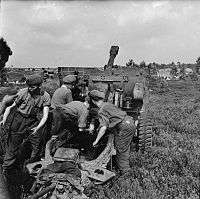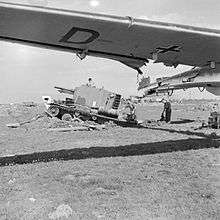This is a list of British Army Yeomanry Regiments converted to Royal Artillery. In the aftermath of the First World War 25 Yeomanry regiments of the British Army were transferred to the Royal Artillery between 1920 and 1922 with another one – the City of London Yeomanry (Rough Riders) – reduced to a battery in another regiment. A further seven regiments were converted during the Second World War.
Background
Under threat of invasion by the French Revolutionary government from 1793, and with insufficient military forces to repulse such an attack, the British government under William Pitt the Younger decided in 1794 to increase the Militia and to form corps of volunteers for the defence of the country. The mounted arm of the volunteers became known as the "Gentlemen and Yeomanry Cavalry".[1] Despite the end of the Napoleonic Wars in 1815, the Yeomanry was retained by the government "for Military Service in aid of the Civil Power" in the absence of organised police forces.[2]
The Yeomanry was not intended to serve overseas, but due to the string of defeats during Black Week in December 1899, the British government realized they were going to need more troops than just the regular army. A Royal Warrant was issued on 24 December 1899 to allow volunteer forces to serve in the Second Boer War. The Royal Warrant asked standing Yeomanry regiments to provide service companies of approximately 115 men each for the Imperial Yeomanry.[3] In the aftermath of the war, a number of new regiments were formed and Haldane's Reforms resulted in a more effective reserve force for home defence.[4] By the outbreak of the First World War, there were 55 regiments.[5][lower-alpha 1]
In accordance with the Territorial and Reserve Forces Act 1907 (7 Edw. 7, c.9) which brought the Territorial Force into being, the TF was intended to be a home defence force for service during wartime and members could not be compelled to serve outside the country. However, on the outbreak of war on 4 August 1914, many members volunteered for Imperial Service. Therefore, TF units were split in August and September 1914 into 1st Line (liable for overseas service) and 2nd Line (home service for those unable or unwilling to serve overseas) units. Later, a 3rd Line was formed to act as a reserve, providing trained replacements for the 1st and 2nd Line regiments.[8][lower-alpha 2]
The experience of the First World War made it clear that cavalry was surfeit. Indeed, by the end of the war, just 17 1st Line regiments remained as mounted cavalry; the rest had been converted to infantry or machine gun battalions.[9] Almost all 2nd Line regiments were converted to cyclists in 1916 and 1917,[9] and the 3rd Line regiments were absorbed into reserve cavalry regiments or reserve infantry battalions.[10]
Post war, a commission was set up to consider the shape of the Territorial Force (Territorial Army from 1 October 1921). Only the 14 most senior regiments were retained as cavalry[lower-alpha 3] (though the Lovat Scouts and the Scottish Horse were also to remain mounted as "scouts"). Eight regiments were converted to Armoured Car Companies of the Royal Tank Corps (RTC),[lower-alpha 4] one was reduced to a battery in another regiment, one was absorbed into a local infantry battalion, one became a signals regiment and two were disbanded.[lower-alpha 5] The remaining 25 regiments were converted to brigades[lower-alpha 6] of the Royal Field Artillery between 1920 and 1922.[20]
Regiments
Converted post-First World War[21][22]
| Yeomanry Regiment |
Artillery Regiment |
| Bedfordshire Yeomanry | 105th (Bedfordshire Yeomanry) Field Regiment, Royal Artillery
52nd (Bedfordshire Yeomanry) Heavy Regiment, Royal Artillery from 1 November 1939 |
| 148th (Bedfordshire Yeomanry) Field Regiment, Royal Artillery |
| Berkshire Yeomanry | 145th (Berkshire Yeomanry) Field Regiment, Royal Artillery |
| Royal Buckinghamshire Hussars | 99th (Buckinghamshire Yeomanry) Field Regiment, Royal Artillery |
| Denbighshire Hussars | 61st (Caernarvon & Denbigh Yeomanry) Medium Regiment, Royal Artillery |
| 69th (Caernarvon & Denbigh Yeomanry) Medium Regiment, Royal Artillery |
| Royal 1st Devon Yeomanry | 96th (Royal Devon Yeomanry) Field Regiment, Royal Artillery |
| 142nd (Royal Devon Yeomanry) Field Regiment, Royal Artillery |
| Queen's Own Dorset Yeomanry | 94th (Queen's Own Dorset Yeomanry) Field Regiment, Royal Artillery |
| 141st (Queen's Own Dorset Yeomanry) Field Regiment, Royal Artillery |
| Royal East Kent Yeomanry (The Duke of Connaught's Own Mounted Rifles) | 97th (Kent Yeomanry) Field Regiment, Royal Artillery |
| 143rd (Kent Yeomanry) Field Regiment, Royal Artillery |
| Essex Yeomanry | 104th (Essex Yeomanry) Regiment, Royal Horse Artillery |
| 147th (Essex Yeomanry) Regiment, Royal Horse Artillery |
| Glamorgan Yeomanry | 81st (Welsh) Field Regiment, Royal Artillery |
| 132nd (Welsh) Field Regiment, Royal Artillery |
| Queen's Own Royal Glasgow Yeomanry | 54th (Queen’s Own Royal Glasgow Yeomanry) Anti-Tank Regiment, Royal Artillery |
| 64th (Queen's Own Royal Glasgow Yeomanry) Anti-Tank Regiment, Royal Artillery |
| Hampshire Yeomanry (Carabiniers) | 95th (Hampshire Yeomanry) Brigade, Royal Field Artillery
72nd (Hampshire) Heavy Anti-Aircraft Regiment, Royal Artillery from 1939 |
| Hertfordshire Yeomanry | 86th (East Anglian) (Hertfordshire Yeomanry) Field Regiment, Royal Artillery |
| 135th (East Anglian) (Hertfordshire Yeomanry) Field Regiment, Royal Artillery |
| 79th (Hertfordshire Yeomanry) Heavy Anti-Aircraft Regiment, Royal Artillery |
| Lancashire Hussars | 106th (Lancashire Hussars) Regiment, Royal Horse Artillery |
| 149th (Lancashire Hussars) Regiment, Royal Horse Artillery |
| City of London Yeomanry (Rough Riders) | 11th (City of London Yeomanry) Light Anti-Aircraft Regiment, Royal Artillery |
| Norfolk Yeomanry (The King’s Own Royal Regt) | Amalgamated with Suffolk Yeomanry on conversion, then separated to form 65th (Suffolk & Norfolk Yeomanry) Anti-Tank Regiment, Royal Artillery |
| Royal North Devon Yeomanry | Amalgamated with Royal 1st Devon Yeomanry on conversion |
| Queen's Own Oxfordshire Hussars | Amalgamated with Worcs Yeomanry on conversion |
| Pembroke Yeomanry | 102nd (Pembroke & Cardiganshire) Field Regiment, Royal Artillery |
| 146th (Pembroke & Cardiganshire) Field Regiment, Royal Artillery |
| South Nottinghamshire Hussars | 107th (South Nottinghamshire Hussars) Regiment, Royal Horse Artillery |
| 150th (South Nottinghamshire Hussars) Regiment, Royal Horse Artillery |
| Suffolk Yeomanry (Duke of York's Own Loyal Suffolk Hussars) | 55th (Suffolk & Norfolk Yeomanry) Anti-Tank Regiment, Royal Artillery |
| Surrey Yeomanry (Queen Mary’s Regiment) | 98th (Surrey & Sussex Yeomanry Queen Mary’s) Field Regiment, Royal Artillery |
| 144th (Surrey & Sussex Yeomanry Queen Mary’s) Field Regiment, Royal Artillery |
| Sussex Yeomanry | Amalgamated with Surrey Yeomanry on conversion |
| Westmorland and Cumberland Yeomanry | 51st (Westmoreland and Cumberland Yeomanry) Field Regiment, Royal Artillery |
| 109th (Westmoreland and Cumberland Yeomanry) Field Regiment, Royal Artillery |
| Queen's Own West Kent Yeomanry | Amalgamated with East Kent Yeomanry on conversion |
| West Somerset Yeomanry | 55th (Wessex) Field Regiment, Royal Artillery |
| 112th (Wessex) Field Regiment, Royal Artillery |
| Queen's Own Worcestershire Hussars | 53rd (Worcestershire and Oxfordshire Yeomanry) Anti-Tank Regiment, Royal Artillery |
| 63rd (Worcestershire and Oxfordshire Yeomanry) Anti-Tank Regiment, Royal Artillery |
Converted during the Second World War[21][22]
| Yeomanry Regiment |
Artillery Regiment |
| Ayrshire (Earl of Carrick's Own) Yeomanry | 151st (Ayrshire Yeomanry) Field Regiment, Royal Artillery |
| 152nd (Ayrshire Yeomanry) Field Regiment, Royal Artillery |
| Lanarkshire Yeomanry | 155th (Lanarkshire Yeomanry) Field Regiment, Royal Artillery |
| 156th (Lanarkshire Yeomanry) Field Regiment, Royal Artillery |
| Duke of Lancaster's Own Yeomanry | 77th (Duke of Lancaster's Own Yeomanry) Medium Regiment, Royal Artillery |
| 78th (Duke of Lancaster's Own Yeomanry) Medium Regiment, Royal Artillery |
| Leicestershire Yeomanry (Prince Albert's Own) | 153rd (Leicestershire Yeomanry) Field Regiment, Royal Artillery |
| 154th (Leicestershire Yeomanry) Field Regiment, Royal Artillery |
| Northumberland Hussars | 102nd (Northumberland Hussars) Light Anti-Aircraft/Anti-Tank Regiment, Royal Artillery |
| Scottish Horse | 79th (Scottish Horse Yeomanry) Medium Regiment, Royal Artillery |
| 80th (Scottish Horse Yeomanry) Medium Regiment, Royal Artillery |
| Shropshire Yeomanry | 75th (Shropshire Yeomanry) Medium Regiment, Royal Artillery |
| 76th (Shropshire Yeomanry) Medium Regiment, Royal Artillery |
|
| Yeomanry gunners in the Second World War |
|---|
| 25 pounders of 430th Battery, 55th Field Regiment (West Somerset Yeomanry), near Hechtel in Belgium, firing in support of Guards Armoured Division in the bridgehead over the Maas-Schelde (Meuse-Escaut) Canal, 16 September 1944 |
|
See also
Notes
- ↑ Two more regiments were formed immediately after the outbreak of the First World War: the Welsh Horse[6] and a third regiment of Scottish Horse.[7]
- ↑ Therefore, the Yeomanry expanded to a total of 171 regiments during the war.
- ↑ The 14 regiments retained as cavalry were:[11]
- ↑ The eight regiments converted to Armoured Car Companies of the Royal Tank Corps (RTC) were:[12]
- ↑ The City of London Yeomanry (Rough Riders) was reduced to a battery in 11th (Honourable Artillery Company and City of London Yeomanry) Brigade, RHA (later re-established as a regiment),[13] the Montgomeryshire Yeomanry was absorbed into the 7th Battalion, Royal Welch Fusiliers,[14] the Middlesex Yeomanry became a signals regiment[15] and the Lincolnshire Yeomanry[16] and the Welsh Horse[17] were disbanded.
- ↑ The basic organic unit of the Royal Artillery was, and is, the Battery.[18] When grouped together they formed brigades, in the same way that infantry battalions or cavalry regiments were grouped together in brigades. At the outbreak of the First World War, a field artillery brigade of headquarters (4 officers, 37 other ranks), three batteries (5 and 193 each), and a brigade ammunition column (4 and 154)[19] had a total strength just under 800 so was broadly comparable to an infantry battalion (just over 1,000) or a cavalry regiment (about 550). Like an infantry battalion, an artillery brigade was usually commanded by a Lieutenant-Colonel. Artillery brigades were redesignated as regiments in 1938.
References
- ↑ Mileham 1994, pp. 8–10
- ↑ Mileham 1994, p. 14
- ↑ Mileham 1994, p. 27
- ↑ Mileham 1994, p. 34
- ↑ Mileham 1994, p. 35
- ↑ James 1978, p. 30
- ↑ James 1978, p. 27
- ↑ Rinaldi 2008, p. 35
- 1 2 James 1978, p. 34
- ↑ James 1978, p. 16–32
- ↑ Mileham 1994, p. 73
- ↑ T. F. Mills. "The Royal Tank Regiment". regiments.org. Archived from the original on January 3, 2006. Retrieved January 9, 2016.
- ↑ Mileham 1994, p. 96
- ↑ Mileham 1994, p. 100
- ↑ Mileham 1994, p. 97
- ↑ Mileham 1994, p. 95
- ↑ Mileham 1994, p. 114
- ↑ "The Royal Artillery". Ministry of Defence (United Kingdom). Archived from the original on October 23, 2013. Retrieved 18 November 2013.
- ↑ Baker, Chris. "What was an artillery brigade?". The Long, Long Trail. Retrieved 18 November 2013.
- ↑ Mileham 1994, pp. 48–51
- 1 2 Barton, Derek. "Yeomanry converted to RA". The Royal Artillery 1939-45. p. 1. Retrieved 13 January 2016.
- 1 2 Barton, Derek. "Yeomanry converted to RA". The Royal Artillery 1939-45. p. 2. Retrieved 13 January 2016.
Bibliography
- James, Brigadier E.A. (1978). British Regiments 1914–18. London: Samson Books Limited. ISBN 0-906304-03-2.
- Mileham, Patrick (1994). The Yeomanry Regiments; 200 Years of Tradition. Edinburgh: Canongate Academic. ISBN 1-898410-36-4.
- Rinaldi, Richard A (2008). Order of Battle of the British Army 1914. Ravi Rikhye. ISBN 978-0-97760728-0.






